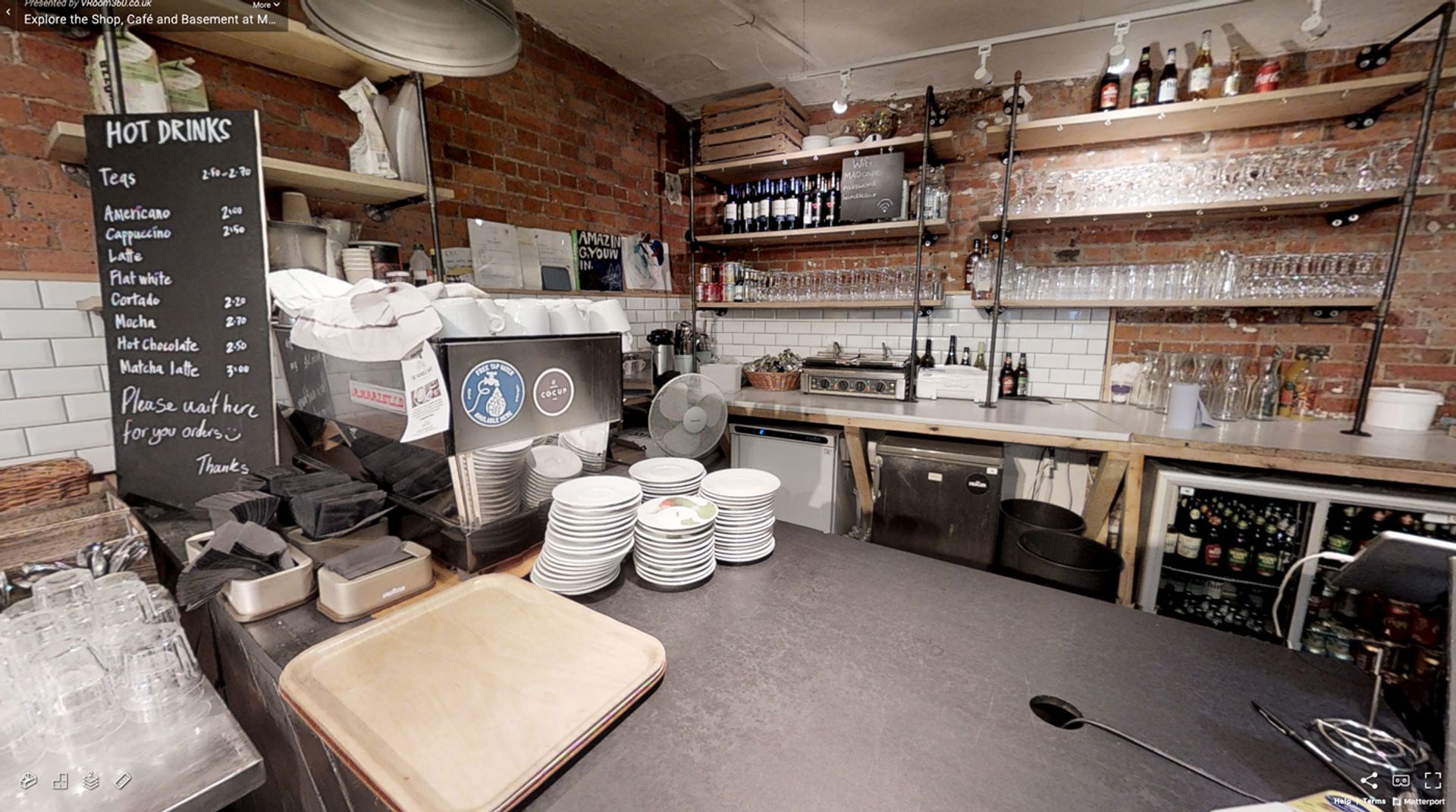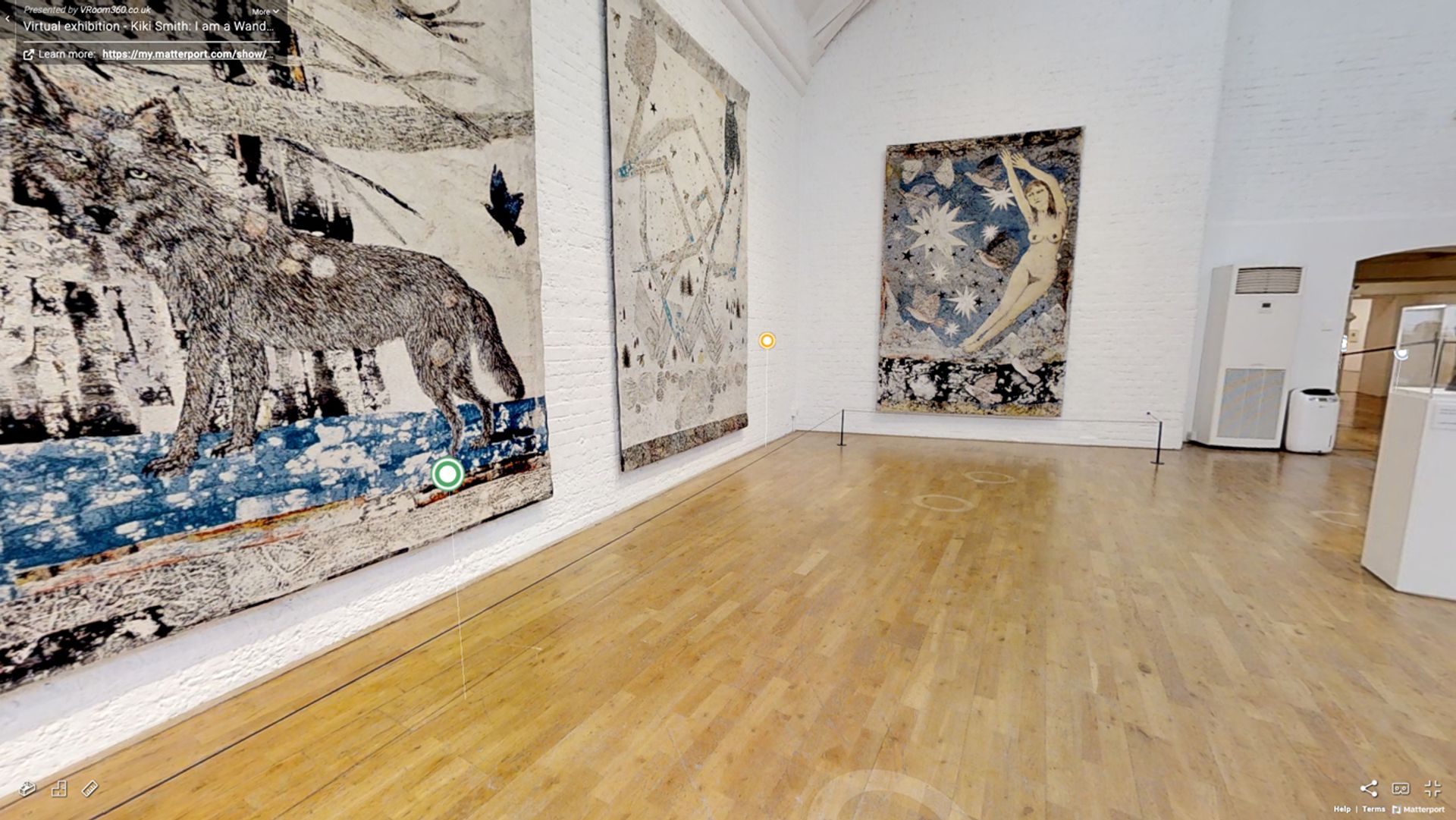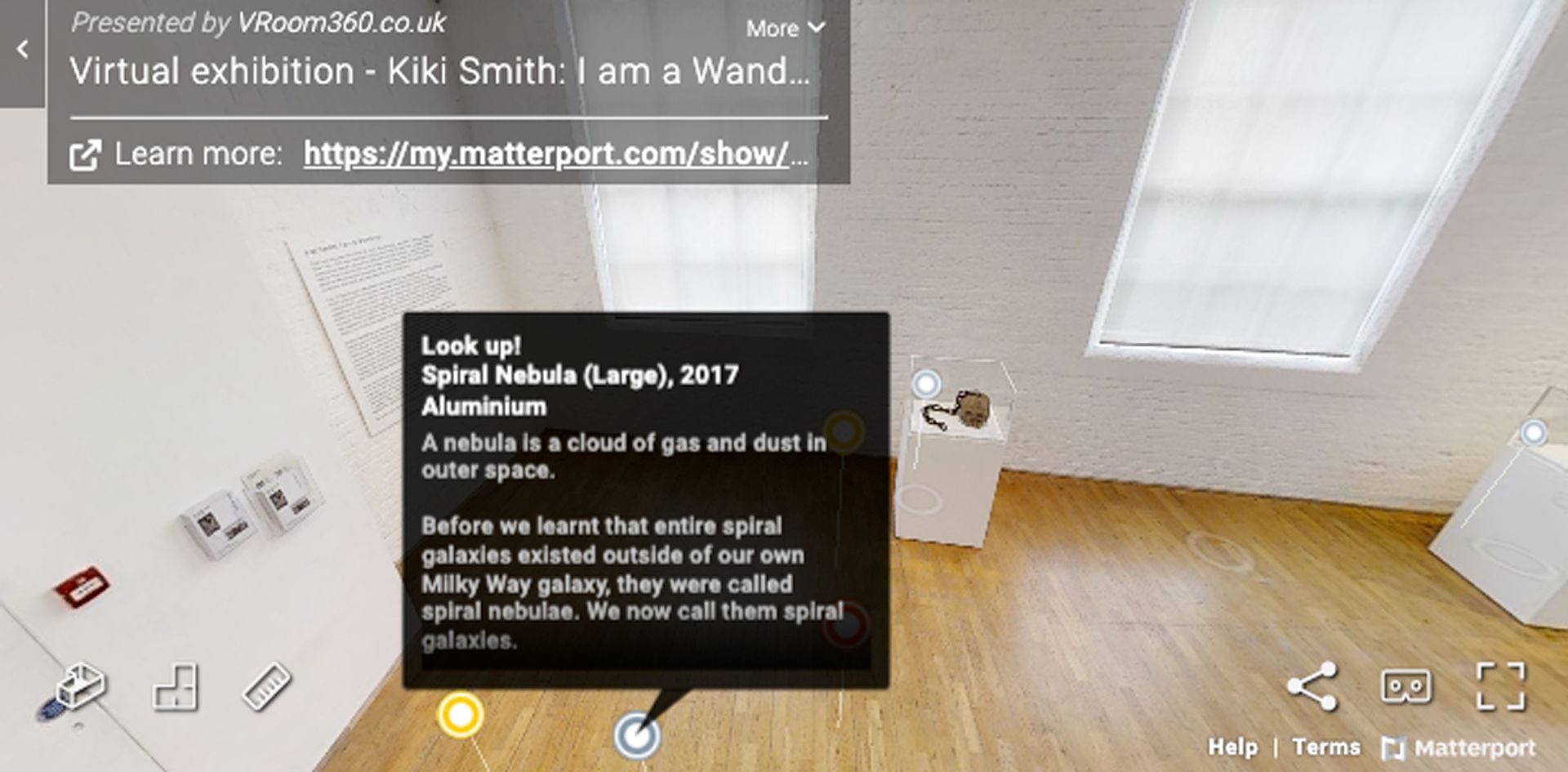Kiki Smith: I am a Wanderer, Modern Art Oxford
Curated by: Petra Giloy-Hirtz.
VR experience produced by: VRoom360.co.uk, a studio specialising in virtual tours, for Modern Art Oxford.
This exhibition by the US artist Kiki Smith (born 1954)—her first solo UK exhibition in a public institution in 20 years—was digitally captured using camera technology created by Matterport—one of the market leaders since 2015 in three-dimensional capture. The Matterport platform stitches together hundreds of shots of an interior to create a virtual tour. The user is teleported through the space by clicking on buttons, or "pins", in a browser or by selecting them by adjusting the gaze when using a stereoscopic headset such as Google Cardboard.
This technology provides one of the quickest ways to market for a gallery wishing to offer an interactive, virtual experience of a physical exhibition, using browser technology, without having to rely on an in-house tech team for production or an app download for distribution. It is an uncomplicated way of documenting a physical exhibition, through digital capture. The panel found that the platform has limitations on image quality and resolution, but pixel perfection in this sphere can come at a cost in time and personnel and, with ultra-large image files, creates challenges in distribution.
One of our panellists, Eron Rauch, gives the experience 3 stars out of 5, but sees the potential of this platform: "The basics of the tech are solid. With some improvements to movement, and, most critically for visual art, the image quality, this will be a very good platform for digital shows."
Modern Art Oxford was closed during the pandemic lockdown and is scheduled to reopen on 2 October 2020.
Where to find it
On the Modern Art Oxford website.
The experience can be viewed on a laptop browser, a smartphone browser or, in full 360, using a smartphone installed in a stereoscopic headset such as Google Cardboard.

The physical exhibition of I am a Wanderer was on show from September 2019 to January 2020
They say:
Enter I am a Wanderer online and discover new insights in Kiki Smith’s works with short videos, behind-the-scenes moments, curator’s notes, children’s activities and more
Modern Art Oxford: ‘I am a wanderer’, Kiki Smith says, and as she roams she collects inspiration from a myriad of sources and cultures. Those looking at her art are transported with her to a multitude of lands and epochs, discovering new forms, materials and stories as they follow her wondrous journey... Enter I am a Wanderer online and discover new insights in Kiki Smith’s works with short videos, behind-the-scenes moments, curator’s notes, children’s activities and more.
The XR panel's ratings
Gretchen Andrew gave a rating of 3.5/5 stars.
Carole Chainon gave a rating of 3.5/5 stars.
Dhiren Dasu gave a rating of 4/5 stars.
Eron Rauch gave a rating of 3/5 stars.
Giving an overall panel rating of 3.5/5 stars
We say:
The art was deep and full-spectrum. I am a Wanderer gave me a feeling of having visited an actual exhibition in the ways that countDhiren Dasu
Dhiren Dasu: Kiki Smith’s I am a Wanderer was very satisfying. It feels like the real thing in so many ways. I loved the ability to move from room to room and that there was more to explore and find in Smith's treasure chest of curiosities and the varied manifestations of her magical world.
The floor plan was a helpful navigational tool. I would have preferred that all the user-interface buttons were grouped together. Because of their location on screen, I did not notice the navigation tools on my first foray. The quality of the overall rendering could be and should be better. Particularly in the context of a fine art application, where one hopes to see an image from afar as well as a detail view. Ideally neither viewing distance should present a challenge. The zoom did not get as close to the art as I would have liked. That is likely a capture/compression issue since the pixels have to be optically captured at a high resolution for such a zoom to be effective.
A visual artefact that made the experience not as immersive as possible was the reflection of the camera. For a photographer, reflections on glass are always a bane. While I understand that photographing framed artwork with appropriate lighting whilst delivering a high-resolution capture is non-trivial, one can’t help but notice the issue here. Another thing that bothered me was seeing areas on the floor, where the camera/tripod was placed, rendered as blurred circles. I expect that the intention was to make the camera disappear. Instead the blur achieved the opposite effect of highlighting the camera placement. I see an optimal use case for the Adobe Photoshop "content aware" fill tool to remedy this visual anomaly.
In summary, the art was deep and full-spectrum. I am a Wanderer gave me a feeling of having visited an actual exhibition in the ways that count. The XR implementation would benefit most of all from higher-resolution capture and user interface tweaks, both of which are entirely within reach.
Is it easy to use?
Just as at the best museums, the ability to do something other than look at art can greatly enhance the experienceGretchen Andrew

The app enables viewers to visit the museum shop and café
Gretchen Andrew: A wanderer is one who travels aimlessly, and aptly in an exhibition of this name, you can be such a person. I found myself testing staircases and was amused to find myself in the shop and café. Just as at the best museums, the ability to do something other than look at art can greatly enhance the experience.
Carole Chainon: A link accessible from your mobile phone or computer web browser is all you need to visit this virtual reality gallery. It is a very intuitive experience. I also enjoyed the Google Cardboard/headset version of the experience.
Dhiren Dasu: Clickable viewpoints on the floor are a successful device to replicate the human experience of viewing a work in a museum. On my web browser (Brave), the kiosk videos would not play nor did the list of works display, even though there were icons signifying their existence. For a more cohesive user interface, the floor plan, doll's house (which models the gallery structure for users) and ruler-view icons could be grouped together with the other social/VR/full screen icons.
Eron Rauch: I find movement in Matterport to be a bit awkward on my computer, since it seems to be forcing me to move at odd diagonals, into places where the art is hard to see, or right through the objects I'm trying to move closer to. Doors and other corners were sometimes awkward to navigate, but I could get around and see most of the mid-sized wall-mounted works fine.
How good is the art?
The tapestries are astounding, even with the show's very compressed digital files. I really want to go see some of them in person!Eron Rauch

The physical ropes captured in this app should inspire a skeuomorphism—a graphical mimicking—in all VR art shows
Gretchen Andrew: How best to retain the status of sacred or fetishised objects in the digital realm? While in this case it was a hangover from the way the piece was produced, I think all VR exhibitions should consider retaining a skeuomorphism—a graphical mimicking—of the ropes originally meant to keep viewers from getting too close in a physical exhibition.
Carole Chainon: The artwork and the scan of the gallery are of good quality overall. The smaller sculptures are unfortunately out of focus and hard to discern.
Dhiren Dasu: The art is excellent. Multi-faceted, multi-media, and using interesting photographic techniques. I really liked the sculptures. The tapestries, paintings and some sculptures do not translate as well in XR because of the challenges of resolution and reflection. I imagine those works look more vibrant and clear in real life.
Eron Rauch: The tapestries are astounding, even with the show's very compressed digital files. I really want to go see some of them in person! But their tactile granularity runs counter to the medium of XR: I was using a 1440-pixel monitor and, at full screen, both the art and space were very pixel-smeared and mushy. Even with the small sculptures, zooming only made matters worse, as it just enlarged the already highly-compressed base file. Especially in the second room, you can't get close enough to get a good view of the central objects in the vitrine. It would have been nice to be able to click works and pop up an in-user-interface window with a better photo. Mid-sized 2D wall works are definitely the technical strength of the platform.
What is gained by enjoying this in VR/AR rather than In Real Life?
It was clearly not designed as a digital-first exhibition and thus retains the ability to transport the viewer to a different physical placeGretchen Andrew
Gretchen Andrew: This exhibition was originally physically open to the public from September 2019 to January 2020. It was clearly not designed as a digital-first exhibition and thus retains the ability to transport the viewer to a different physical place. It has an indisputable sense of place. It also means that it is unlikely the artist considered the digital experience when installing.
Carole Chainon: This is an exhibit I would have missed were it not available virtually. I was able to explore the artwork and teleport through the gallery without any interference from people or sounds, which would rarely happen in real life.
Dhiren Dasu: Given the current limitations on travel and gatherings, for the majority of us this is the only way to view such an exhibition. Everything is gained from this XR viewing.
Eron Rauch: The main advantage to XR here is simply access: I could see a show I otherwise couldn't. However, the materiality of the works in the show combined with the mushy digital renderings meant seeing it online was an across-the-board downgrade from seeing the show in person.
What medium-specific qualities of VR/AR does it employ?
A series of 'pins' ... provide less 3D-world-savvy audience members with good guidance on what is a point of interest/interactionEron Rauch

Coloured pins guide viewers to new pieces and to information panels on the work
Gretchen Andrew: As the exhibition was physically hung and then digitally recorded, the image quality is low, rendering the wall labels illegible. Its transfer into VR is more one of documentation than digital exhibition.
Carole Chainon: The 360 capture using a Matterport camera highlights points of interest within the virtual space. We are unable to walk around but are teleported (by adjusting our gaze to select interactive buttons) from one point of interest to another, and are able to move our head around.
Dhiren Dasu: The use of viewpoints, zooms, pans and the ability to navigate to different rooms in the exhibition are all hallmarks of XR. I used the browser-based version so I cannot speak for any additional functionality of the headset experience.
Eron Rauch: This app uses a series of "pins" (similar to digital mapping systems) to guide you around the space, which is a bit crude in the way their pure colours overwhelm the muted tones of the art. But these ultimately provide less 3D-world-savvy audience members with good guidance on what is a point of interest/interaction.
Does it break new ground technically?
A very effective method for art galleries to share their content with a wider audience, especially one not equipped with VR headsetsCarole Chainon
Gretchen Andrew: The YouTube videos showing Smith’s influences are smartly integrated but no technical frontier has been breached.
Carole Chainon: 360 capture has been around for five years or more but it is still a very effective method for art galleries to share their content with a wider audience, especially one not equipped with VR headsets.
Dhiren Dasu: The ease of use and display, in a digital format akin to the physical experience, is in itself a novel way for most people to experience art.
Eron Rauch: One (perhaps over-indexed) criterion of video games is "game feel". In this deployment of the Matterport tech, I noticed something related to what we might call "XR feel": When you use the mouse to move the camera, there is a strange virtual physics momentum that causes the camera to slide past where I stop—like a large boat trying to stop.
The Art Newspaper's XR Panel
Gretchen Andrew is a Search Engine Artist and Internet Imperialist who programs her vision boards to manipulate the internet with art and desire.
Dhiren Dasu is a digital media creator and consultant. His areas of speciality include photography, film, virtual space, graphic design, visual effects, animation, and audio production. Dasu, in his fine art persona as Shapeshifter7, makes artworks that echo and recompose the architectural spaces he photographs, turning them into immersive spaces while exploring the nexus of photography, collage, symbols, and perception.
Carole Chainon is the co-founder of JYC, a XR development and production studio based in LA with a presence in Europe, creating XR experiences for the entertainment and enterprise sector. She is also a Spark AR Creator.
Eron Rauch is an artist, writer, and curator whose projects explore the infrastructure of imagination, with a focus on subcultures, video games, and photography history.


